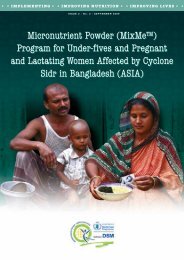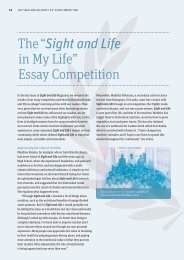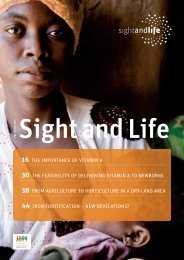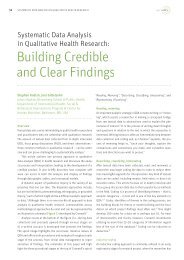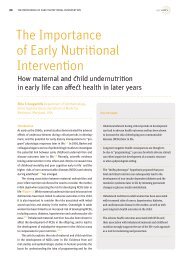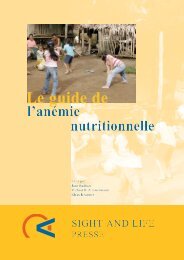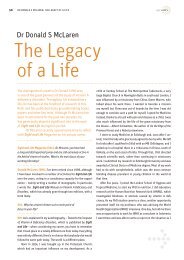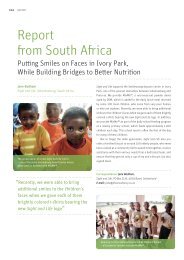16 intrauterine programming of ncd 24 olson memori... - DSM
16 intrauterine programming of ncd 24 olson memori... - DSM
16 intrauterine programming of ncd 24 olson memori... - DSM
- No tags were found...
You also want an ePaper? Increase the reach of your titles
YUMPU automatically turns print PDFs into web optimized ePapers that Google loves.
6EDITORIALAfrican people better <strong>of</strong>f? No … Aid has helped make the poorpoorer, and growth slower.” She follows the aid culture fromthe 1960s, which she defines as the decade <strong>of</strong> industrialization,through the 1970s (“the shift to poverty”), to the 1980s (“thelost age <strong>of</strong> development”) and the 1990s (“a question <strong>of</strong> governance”),and into the 2000s, which she refers to as “the rise<strong>of</strong> glamour aid.” Moyo ascertains that we need to abandon ourobsession with aid and, instead, focus on proven financial solutionsand models – which, she says, should not be on a one-sizefits-allbasis. Above all, she states that what is needed, but whatis lacking, is political will.We can and must advocate for the political will componentand are grateful that the Scaling Up Nutrition (SUN) movementrecognizes, in the words <strong>of</strong> Special Representative on Food Securityand Nutrition to the UN Secretary General, David Nabarro,that the main investors in SUN are national governments themselves.However, those <strong>of</strong> us involved in humanitarian work alsoneed to look at how we have done things in the past and reassessand be open to change! We cannot simply be do-gooders– which, as the dictionary states, is a disparaging term for awell-intentioned, naive idealist who supports philanthropic orhumanitarian causes or reforms.Research and programs at scale in parallelThe challenge we face going forward, however, is the need tobalance the evidence, which is critical to forming and growingknowledge, and to continue monitoring, evaluating and fine tuningthe policies that guide public health nutrition, with turningthe evidence into scaled-up programs at the community levelwhere there is a real urgency for delivery. The dilemma is to decidewhether more research is still needed to sharpen our knowledge<strong>of</strong> what to do and how to do it, or whether we should turnimmediately to the scaling up <strong>of</strong> interventions at a country levelto achieve the MDGs. Perhaps this is a case <strong>of</strong> ensuring that bothresearch and programs at scale run in parallel and both receiveadequate attention and funding. If we neglect one for the other,we could find in future that we have missed an important piece<strong>of</strong> the puzzle.We also need to tread carefully between the triumphalism– the attitude or belief that a particular doctrine, religion, culture,or social system is superior to and should triumph overall others – necessary for advocacy, and the realism relative tothe potential risks and benefits and nutrition <strong>programming</strong>’slimitations. The time has come to break down the silos in whichwe have traditionally functioned and to build meaningful partnershipsacross multiple cross-cutting disciplines: the need fordirect nutrition interventions, together with nutrition sensitiveinvestments. Ultimately, none <strong>of</strong> our individual actions directlyresult in reaching the goal <strong>of</strong> the improved nutritional status <strong>of</strong>the world’s population. It is the compounded effects <strong>of</strong> all ouractions that lead to a world where this goal becomes possible.We cannot “do nothing”In a world where so many families still live in poverty, wheresome billion people go to bed hungry each night, and hundreds<strong>of</strong> millions <strong>of</strong> children will never reach their full potential because<strong>of</strong> micronutrient deficiencies and inadequate care, doingnothing is not an option. We must not become paralyzed by theenormity <strong>of</strong> the challenges we face. What is so insidious aboutthe absence <strong>of</strong> action is that no single decision to delay ever appearsmonumental at the time. Because the cost <strong>of</strong> inaction takestime to be fully revealed, it does not necessarily impact the worldtoday, but may well severely affect the world <strong>of</strong> tomorrow.By and large, policy makers are risk averse, which perpetuatesthe cycle <strong>of</strong> inaction: They would rather do nothing todaythan run the greater risk <strong>of</strong> taking the wrong decision. This confersan ethical dimension on the risk <strong>of</strong> doing nothing, but thisis a discussion on its own. Ultimately, I strongly believe that, despitethe risk involved, doing something outweighs doing nothing– but I also believe that it is time to reassess what we do andhow we do it …With best regards,“And the day came when the riskit took to remain tight inthe bud became greater than the riskit took to blossom”Anais Nin



